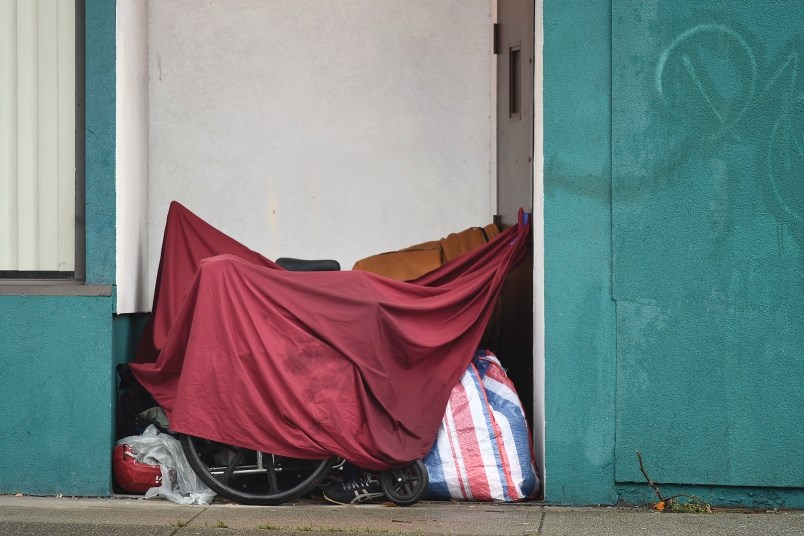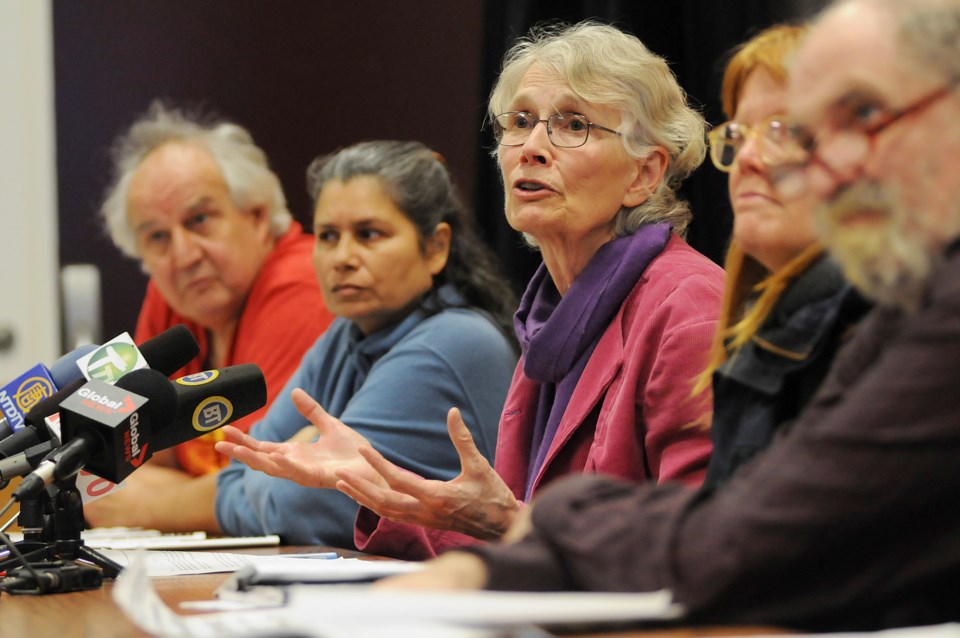Jean Swanson sent me an email the other day to let me know the Carnegie Community Action Project released its annual report card on housing and homelessness in the Downtown Eastside.
It’s never good reading.
Swanson knows this, and in her email, I could sense her exasperation as she pointed to ‚Äúthe usual recommendations‚ÄĚ that she and the co-authors of the report include every year.
There‚Äôs a long list of recommendations aimed at all three levels of government. Swanson provided me with a few in her email that sum up some of the action requested: ‚ÄúBuild 5,000 units of social housing low-income people can afford in the DTES; bring in rent control on the unit, not the tenant; raise welfare high enough to pay rents; city and province to acquire [single-room-occupancy] hotels to keep them from being gentrified; in particular, the Arlington rooms at 575 E. Pender, which is for sale and has 30 rooms.‚ÄĚ
The recommendations are in response to what she, Maria Wallstam, Lenee Son, King-mong Chan, Beverly Ho and Lama Mugabo found in their research this time.
Some of their findings:
·        The average rent in privately owned and operated single-room-occupancy hotels is $548 a month; the welfare shelter rate is $375 per month.
¬∑¬†¬†¬†¬†¬†¬†¬† Average rents of the nine ‚Äúfastest gentrifying hotels‚ÄĚ are $1,101, an increase of $196 over last year‚Äôs examination of this trend.
·        Only 11 new units of welfare/pension rate housing opened in the Downtown Eastside in 2016.
¬∑¬†¬†¬†¬†¬†¬†¬† The rate of change in Chinatown ‚Äúfor the foreseeable future‚ÄĚ is that 362 unaffordable units will be built for every four affordable units that will be lost.
·        A total of 972 homeless people were counted in the Downtown Eastside in the city’s 2016 homeless count, which the city has acknowledged is an undercount.
·        With a total population of about 18,000 people in the Downtown Eastside, that means about one in 18 people are homeless in the area.

Swanson has been at this for a long time, pushing and poking politicians to do the right thing for the city’s most vulnerable. She knows her stuff and was recognized for her work last year with the Order of Canada.
Some might wonder why she hasn’t sought political office, as many people do when the ground game is not as effective as the political game.
The answer is, she did.
Back in 1988, Swanson ran unsuccessfully for mayor against the NPA’s Gordon Campbell, who would later go on to become premier of the province (and continue to be a thorn in the side of anti-poverty activists). Swanson was the COPE/Civic NDP candidate.
I was curious what the issues were in that election and found the answer in a book that examined COPE’s history from 1968 to 1993. I also found a quote from Swanson.
‚ÄúWe forced them to deal with these issues, to discover that not everyone in ¬ť∂Ļīę√Ĺ”≥Ľ≠lives in mansions or $1,000-a month apartments,‚ÄĚ she said of her campaign fight against the NPA that focused on the ‚Äúlack of affordable housing in this city.‚ÄĚ
That was 29 years ago.
Swanson began work as an organizer for the now-defunct Downtown Eastside Residents’ Association in 1974. That was 43 years ago, when welfare rates were substantial enough for a person to find a place to rent. Social housing was also being built.
That’s what Swanson remembers about that time.
Now in her 70s, she hasn’t completely lost hope in her 40-plus years fight to get people off the street and into a home. She’s buoyed by the compassion and passion of the many young people she is surrounded by in her work.
‚ÄúI‚Äôm just trying to keep the idea alive that we don‚Äôt have to have homelessness,‚ÄĚ she told me by telephone. ‚ÄúThere are things governments could do that would end homelessness. I keep using these two facts -- that homeless people have half the life expectancy as other people, and it‚Äôs cheaper to house homeless people than keep them on the streets. That should be enough to get people working on it.‚ÄĚ
She hopes she lives long enough to see the day when the blurred focus of political leaders on this file sharpens and they wipe out what she and her young friends have described as ‚Äúa humanitarian emergency.‚ÄĚ Volunteers counted 1,847 homeless people in ¬ť∂Ļīę√Ĺ”≥Ľ≠in March 2016.¬†
‚ÄúIt would be nice to happen before I croaked. If it doesn‚Äôt, maybe it will happen later with [her young friends]. It‚Äôs out there in everybody‚Äôs face, so something has got to happen.‚ÄĚ
* * * * * * * * * * * * * * * * *
Ī∑ī«≥ŔĪū:ŐżThe federal government releases its budget today, and it is anticipated that details of a national housing strategy will be discussed in the announcement. The City of ¬ť∂Ļīę√Ĺ”≥Ľ≠is expected to release more details of its so-called ‚Äúhousing re-set‚ÄĚ later this week.
I requested to speak to Housing Minister Rich Coleman yesterday about the Carnegie report, but was instead emailed a lengthy bullet-point list of provincial government initiatives in the Downtown Eastside.
Here’s what I received, in the government’s own words:
·         In 2015/16, the Province invested approximately $91 million to support more than 8,300 low-income households in the Downtown Eastside.
·        Since 2001, we have created or preserved close to 3,400 units of affordable housing in the DTES.Close to 2,400 of these units provide emergency shelter and housing for those who are homeless or most at risk of homelessness.
¬∑¬†¬†¬†¬†¬†¬†¬† In 2007, BC Housing acquired 24 Single Room Occupancy (SROs) hotels in Vancouver, 20 of these are in the DTES. The purchase of these SROs has protected more than 1,300 affordable housing units in ¬ť∂Ļīę√Ĺ”≥Ľ≠(more than 1,000 of these units are in the DTES).
·        As part of the Single Room Occupancy Hotel Renewal Initiative (SRI), the Province invested $147 million to renovate 13 SROs in Vancouver, 11 of which are located in the DTES. Renovations on all 13 SRO hotels were completed in February 2017.
·        In 2014/15 the Homeless Prevention Program (HPP) was launched providing portable monthly rent supplements in the private market.  Last year, approximately 165 HPP rent supplements were allocated to service providers in the DTES.
·        Although Aboriginal Peoples are supported across the housing continuum, approximately 325 housing units are specifically designated to provide Aboriginal Peoples with access to safe, secure and culturally appropriate housing in the Downtown Eastside.
·        In 2015/16 more than 475 new shelter spaces, rent supplements and housing units were created in the Downtown Eastside, including more than 240 for individuals who are homeless.
In development/under construction ‚Äď 31 December, 2016 - Vancouver
·        As of December 31, 2016 there are more than 1,035 new housing units in development or under construction in the city of Vancouver. They include approximately 230 units for those who are homeless or most at risk of homelessness. Of the more than 1,035 new housing units, approximately 480 of these units will be new supportive housing.
·        As announced in November 2016, through the PIAH/IHI investment, the province is investing approximately to provide approximately $49.4 million to provide more than 610 additional units in the city of Vancouver, (approximately $21.9 million of which will provide close to 365 supportive housing units.)



